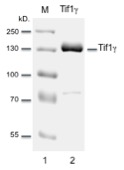|
|
Recombinant human Tif1γ (Trim33)
Catalog # : EPX-006-RBV
Source : Human
Expressed in : SF9 cells
Quantity : 10µg of
enzymatically active recombinant Tif1γ at 0.5µg /µl
Background:
Tif1γ (Trim33) is an E3 ubiquitin-protein ligase, which
promotes
SMAD4 ubiquitination, nuclear exclusion and degradation via the
ubiquitin proteasome pathway (1, 2). May act as a transcriptional
repressor. Inhibits the transcriptional response to TGF-beta/BMP
signaling cascade. Plays a role in the control of cell proliferation.
Its association with SMAD2 and SMAD3 stimulates erythroid
differentiation of hematopoietic stem/progenitor By similarity.
Monoubiquitinates SMAD4 and acts as an inhibitor of SMAD4-dependent
TGF-beta/BMP signaling cascade (Monoubiquitination of SMAD4 hampers its
ability to form a stable complex with activated SMAD2/3 resulting in
inhibition of TGF-beta/BMP signaling cascade) (2). Defects in TRIM33
are a cause of thyroid papillary carcinoma (3).
Protein details:
Recombinant human N-terminal FLAG tagged Tif1γ was produced in SF9 insect cells, purified using FPLC and formulated in a storage buffer containing 20mM Tris-Cl pH 7.6, 1mM EDTA, 0.15 M NaCl, 10% glycerol, 0.5mM PMSF and 1mM DTT. Protein concentration was determined by spectrometry. >95% purity by SDS-PAGE.
Quality control:
Each lot has been evaluated by 10% Tris Glycine SDS-PAGE
Ubiquitylation assay:
Tif1γ modification with ubiquitin (Ub) was reconstituted
in vitro in
the presence of recombinant E1, E2, Ub and ATP. Tif1γ
auto-ubquitylation results in a mobility shift of 8kDa. The efficiency
of in vitro auto-ubiquitylation is evaluated by 8% Tris Glycine
SDS-PAGE.
Storage:
-80°C
Guarantee:
For research use only. Products guaranteed stable for 2 years from date of receipt when stored properly.
Sequence:
MAENKGGGEAESGGGGSGSAPVTAGAAGPAAQEAEPPLTAVLVEEEEEEGGRAGAEGGAA
References: 1. Venturini et al.,
Oncogene 18:1209-1217(1999) |
|---|
© 2011-2016 EpiGex. All rights reserved



